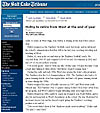|
 May
30, 2008: The Salt Lake Tribune May
30, 2008: The Salt Lake Tribune
Q and A about the UHSAA
UHSAA: Transfer rule never solved
UHSAA boss has few critics anymore
1. What is the Utah High School Activities
Association (UHSAA)?
A collection of 128 member schools
(probably 135 by 2009) that cooperate together to
administer and supervise interscholastic activities
according to its bylaws and constitution. Although schools
have been organized into leagues for competition since
1910, the UHSAA considers 1927 as its founding date
because the overhaul of its constitution that year
essentially created a new organization.
2. What does the UHSAA do?
Its primary duty is to run high school
state tournaments in 22 sports and competitions in
nonsports activities involving music, speech and drama.
However, it also determines regions and classifications
with its every-four-years realignment process and is
charged with determining eligibility for more than 80,000
student-athletes.
3. How is the UHSAA governed?
The governing body of the UHSAA is known
as the Board of Trustees. It includes 19 school board
members (one for each region), a state school board
member, two superintendents and five high school
principals (one from each classification). The Board of
Trustees is responsible for setting UHSAA policy. Most
notably it aligns schools based on geography and size into
classifications and regions. A secondary ruling body is
known as the Executive Committee and is comprised of one
member from each region (usually a principal) and one
representative from the state office of education.
The Executive Committee administers the policies and
directives of the Board of Trustees. An office staff of
seven full-time employees, based in Midvale, runs the
day-to-day operations of the UHSAA and is headed by an
Executive Director. Evan Excell is stepping down after 14
years as the Executive Director on July 1 and will be
replaced by Dave Wilkey, a longtime Associate Director. A
list of all the members of the UHSAA's governing boards
can be found at
www.uhsaa.org.
4. Is the UHSAA a branch of state
government?
No. However, it works in consultation with
the Utah State Board of Education, the Utah State Office
of Education, the Utah School Boards Association and
governing boards of private schools. A member of the USBE
sits on the BOT and a staff member of the USOE sits on the
Executive Committee. Courts in various states have
determined state associations to be "state actors" but not
state agencies.
5. How is the UHSAA funded?
The UHSAA has an annual budget of nearly
$2 million. About 68 percent of its funding comes from
state tournament gate receipts. Some 13 percent comes from
rule book sales, state tournament program sales, officials
fees and the sale of annual passes. Corporate sponsorships
account for about 11 percent and school dues the final 8
percent.
6. Does taxpayer money support the UHSAA?
No. Small membership dues are assessed
based on school size. There is a base annual fee of $500
and $40 for each sport or activity the school participates
in (so, larger schools pay a bit more because they sponsor
more sports and activities). When state tournaments are
held at venues owned by municipalities or state-owned
colleges, the UHSAA pays a rental fee for those
facilities.
7. What sports does the UHSAA sponsor?
Baseball, *basketball, *cross country,
drill team, football, *golf, *soccer, softball, *swimming
and diving, *tennis, *track, volleyball, wrestling.
*boys and girls.
8. What non-sports activities does it
sponsor?
Jazz festival, solo/ensemble festival,
forensics, debate and drama
9. How many students are involved?
In the 2006-07 school year, 43,422 boys
and 38,448 girls participated in at least one sport
sanctioned by the UHSAA
10. Which high school sports does the
UHSAA have no control over?
The main ones are hockey, lacrosse, water
polo, boys volleyball, rodeo, skiing, bowling and
cheerleading and are generally referred to as "club"
sports.
11. Will the UHSAA add (sponsor) another
sport in the near future?
Probably not, because of the costs to its
member schools and to itself. However, if a new sport is
added it will likely be lacrosse because of its growing
popularity in Utah and because it could be added for boys
and girls to meet Title IX requirements.
12. Why does the UHSAA limit the
transferring of student-athletes between schools and care
so much about where students play?
Part of its charge is to "create a level
playing field" among its member schools, and allowing
schools to become "superpowers" in particular sports
through recruiting or undue influence runs contrary to
that charge, it believes.
Sources: UHSAA handbook, interviews with
UHSAA officials
|